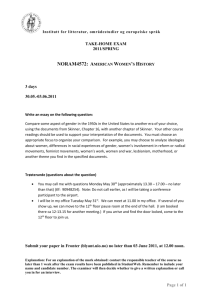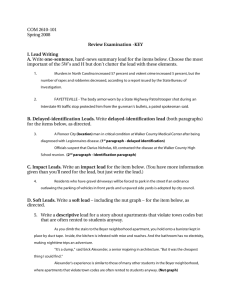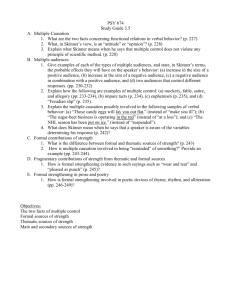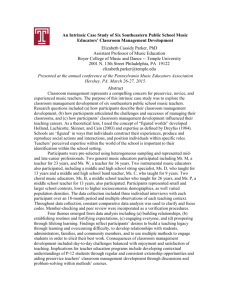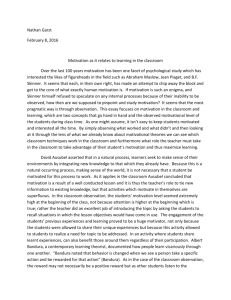CSISS Classics - G. William Skinner: Marketing in Rural
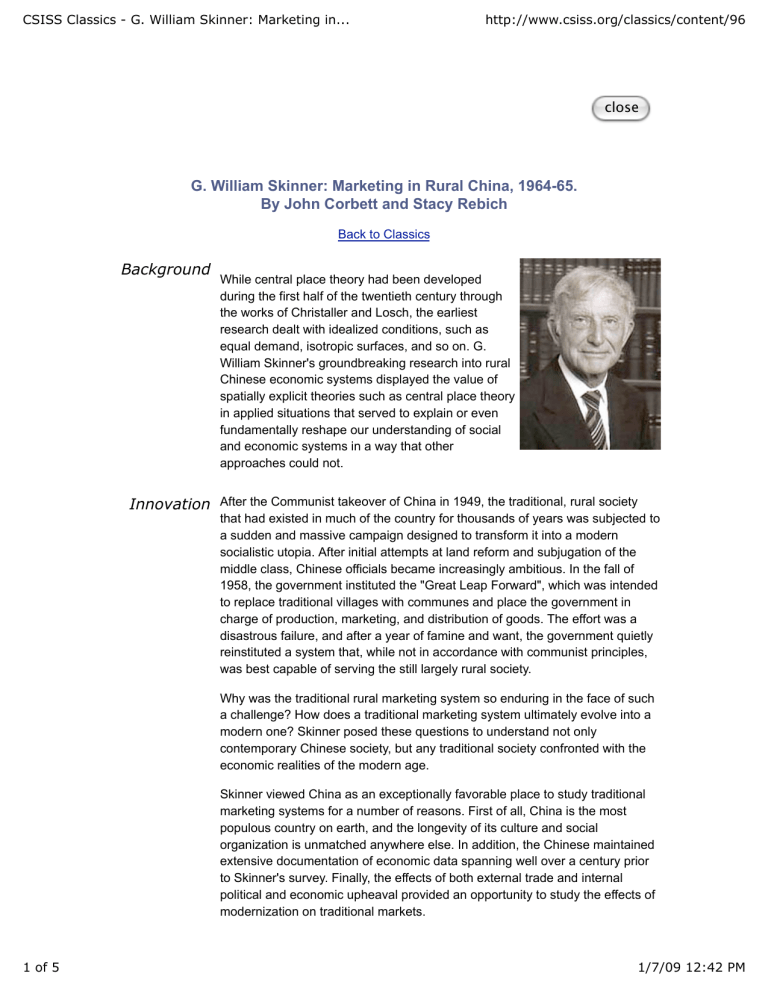
CSISS Classics - G. William Skinner: Marketing in...
http://www.csiss.org/classics/content/96
1 of 5
close
G. William Skinner: Marketing in Rural China, 1964-65.
By John Corbett and Stacy Rebich
Back to Classics
Background
While central place theory had been developed during the first half of the twentieth century through the works of Christaller and Losch, the earliest research dealt with idealized conditions, such as equal demand, isotropic surfaces, and so on. G.
William Skinner's groundbreaking research into rural
Chinese economic systems displayed the value of spatially explicit theories such as central place theory in applied situations that served to explain or even fundamentally reshape our understanding of social and economic systems in a way that other approaches could not.
Innovation
After the Communist takeover of China in 1949, the traditional, rural society that had existed in much of the country for thousands of years was subjected to a sudden and massive campaign designed to transform it into a modern socialistic utopia. After initial attempts at land reform and subjugation of the middle class, Chinese officials became increasingly ambitious. In the fall of
1958, the government instituted the "Great Leap Forward", which was intended to replace traditional villages with communes and place the government in charge of production, marketing, and distribution of goods. The effort was a disastrous failure, and after a year of famine and want, the government quietly reinstituted a system that, while not in accordance with communist principles, was best capable of serving the still largely rural society.
Why was the traditional rural marketing system so enduring in the face of such a challenge? How does a traditional marketing system ultimately evolve into a modern one? Skinner posed these questions to understand not only contemporary Chinese society, but any traditional society confronted with the economic realities of the modern age.
Skinner viewed China as an exceptionally favorable place to study traditional marketing systems for a number of reasons. First of all, China is the most populous country on earth, and the longevity of its culture and social organization is unmatched anywhere else. In addition, the Chinese maintained extensive documentation of economic data spanning well over a century prior to Skinner's survey. Finally, the effects of both external trade and internal political and economic upheaval provided an opportunity to study the effects of modernization on traditional markets.
1/7/09 12:42 PM
CSISS Classics - G. William Skinner: Marketing in...
2 of 5 http://www.csiss.org/classics/content/96
Rural hierarchy
In creating a model for the behavior of rural Chinese markets, Skinner turned to
Christaller's central place theory. One of the key aspects of the theory is its emphasis on an economic hierarchy that focuses higher-level economic activity in relatively few "centers"; while successively lower services become increasingly dispersed in a rough, triangular-lattice spatial structure.
At the root of rural economic activity in China was the village . The average peasant lived here with his family and engaged in a largely subsistence existence, producing goods for immediate consumption. It would be wrong, however, to view such a family or a village as being a closed system, entirely self-reliant. Excess food, clothing or other goods were produced. Such items flowed upward to the next step in the hierarchy: what Skinner dubbed the standard market town . "What [the village] household produced but did not consume was normally sold there," Skinner observed of the standard market town. In addition, "what [the village household] consumed but did not produce was normally bought there."
The standard market town itself only had a limited range of goods available.
Itinerant merchants would travel to and from intermediate market towns which represented the next level. At the top of the rural hierarchy were the central market towns , which were the most rarified and had the most exclusive items available. Beyond the central market town, we move into local cities and regional cities , which were beyond the scope of Skinner's rural model.
Periodic markets
Unlike markets in the industrialized world, in which firms have a permanent presence in a given location and operate on nearly continuous schedules, in rural China marketers were mobile, and the markets they frequented operated on a periodic basis. Such periodicity grew out of economic necessity. Village producers needed to divide their time between creating goods at home and selling them at the market. Itinerant peddlers also benefited from such an arrangement, since no single market could generate enough demand for their wares. Periodic markets allowed them to take advantage of multiple markets, whether horizontally within several standard markets or vertically between two or more levels in the hierarchy.
Markets operated on a number of schedules throughout China. The frequency of the periodicity depended partly on the custom of the region, and partly on the level of supply and demand for a given market. For example, the hsn , or
"decade" for ten-day period, was used in the way that industrialized societies use the work week. A standard market might operate on a 1-4-7 schedule, meaning that it would be in business during every first, fourth, and seventh day of a hsn . Skinner argued that trade logically flowed vertically through the hierarchy, so while a neighboring standard market might have competing market dates, an intermediate market would not. In the example above, if the intermediate market operated on a 2-5-8 schedule, merchants could visit both the standard and intermediate markets, and trade would flow properly up and down the economic hierarchy.
1/7/09 12:42 PM
CSISS Classics - G. William Skinner: Marketing in...
http://www.csiss.org/classics/content/96
Hexagonal harmony
In central place theory, settlements at a given level in a hierarchy will be situated in a perfectly triangular lattice. As the circular markets around them expand, they will eventually meet the markets of other settlements. If the settlements are spread evenly, and the market boundaries are drawn halfway in between each, a series of hexagonal-shaped markets appear. Delving still further into the theory, the optimal number of lower-level settlements around such a settlement would be six, one toward each corner of the hexagon.
Skinner argued that the optimal number of rings around the typical standard market town and within the marketing area would be two, with six villages in the first ring, and twelve in the second.
Although such structure would seem to be the stuff of idealized theory, Skinner put forth evidence that indeed there were, on average, roughly eighteen villages within each standard marketing area (i.e., the hexagonally-shaped area surrounding the standard market town). Going further, Skinner argued that all eighteen villages should be exclusively within a single standard marketing area , while the standard marketing towns themselves were on the boundaries of two or three different intermediate marketing areas . The latter relationship would hold true for all higher levels within the hierarchy.
While such questions of insularity may sound like a technical distinction, for
Skinner it had crucial social and economic ramifications. He argued that the discrete nature of standard marketing areas caused them to become the basic organizing unit of Chinese society and economic order -- not the village as was widely believed. He even alternately termed them standard marketing communities . Standard marketing communities were asserted to have common lineage, dialects, even deities. Since standard marketing communities were largely insular, Skinner posited, "the development of cultural distinctiveness as between marketing communities would appear inevitable."
Market development and evolution
Over the course of his research, Skinner noticed that many standard market towns were surrounded by substantially more or less than eighteen villages. He asserted that the eighteen-village rule was the equilibrium to which the system naturally gravitated. His developmental theory went something as follows. As new villages sprang up on the countryside, the standard market town first dealt with the situation by adding additional market hours and days. Soon, the town would become overwhelmed -- the situation in which the number of villages was substantially higher than eighteen.
To restore equilibrium, new standard marketing towns would spring up roughly halfway between the town and other nearby standard marketing towns. The town itself would be forced higher up the hierarchy and become an intermediate marketing town (as would the other pre-existing standard marketing towns). Now, there would be more than enough standard marketing towns as compared with the number of villages -- the situation in which the number of villages was substantially lower than eighteen. Eventually equilibrium would be achieved until the next round of growth began.
3 of 5 1/7/09 12:42 PM
CSISS Classics - G. William Skinner: Marketing in...
http://www.csiss.org/classics/content/96
Modernization
Skinner bristled at commentators who spoke of the "modern" Chinese economic system. As he saw it, during the course of the nineteenth and early twentieth centuries, China had developed at best a partially modern system, in which some of the higher-level cities and central market towns were linked by efficient transportation, such as railroads and improved and straightened roads.
The standard and intermediate market towns in such limited regions were obviated in the sense that villagers could more readily leapfrog right up the hierarchical ladder to the central market town to do their business. Skinner believed that observers located in such areas made the fundamental mistake of projecting their observations across China, when most rural areas were still operating under the traditional system. Most rural areas that were undergoing
"modernization" were in fact experiencing nothing but additional trading volume, leading to new markets along the traditional lines described in the previous section.
During the late 1950s, when the Chinese government attempted to replace the traditional marketing system with communes and government run-markets, the result was a failed crop and tons of wasted goods that failed to find their way to the market. Skinner attributed this in large part to the communist government's inability to manage the entire system down to the village level due to the sheer scale of such a project. He also blamed urban-based technocrats who believed that bigger settlements were desirable and created communes far larger than traditional villages and out of sync with the size and equilibrium of standard market communities. Skinner did not rule out such larger-scale communities in the future, but observed that modernity could not be imposed on a rural structure that did not have the infrastructure or transportation network inherent in a modern, industrial society. Eventually, Mao Zedong fell from grace, and the policies were reverted to accommodate the traditional rural marketing structure described by Skinner.
Publications
Marketing and social structure in rural China (Ann Arbor, MI: Association for
Asian Studies, c1964). (2001 printing)
Chinese peasants and closed community - open and shut case, Comparative
Studies in Society and History , 13(3): 270-281, 1971.
The structure of Chinese history, Journal of Asian Studies , 44(2): 271-292,
1985
Related
Works
Lin, G.C.S., State, capital, and space in China in an age of volatile globalization, Environment and Planning A , 32(3): 455-471, 2000.
Wigen, K., Culture, power, and place: The new landscapes of east Asian regionalism, American Historical Review , 104(4): 1183-1201, 1999.
Yeung, H.W.C. and Lin, G.C.S., Theorizing economic geographies of Asia,
Economic Geography , 79(2): 107-128, 2003.
4 of 5 1/7/09 12:42 PM
CSISS Classics - G. William Skinner: Marketing in...
http://www.csiss.org/classics/content/96
McKim, W., Periodic market system in northeastern Ghana, Economic
Geography , 48(3): 333-344, 1972.
Links
China's fertility transition through regional space
Publications by G. William Skinner
Regional Systems Analysis at UC Davis
Forman, S. and Riegelhaupt, J.F., Market place and marketing system -toward a theory of peasant economic integration, Comparative Studies in
Society and History , 12(2): 188-212, 1970.
Copyright © 2001-2009 by Regents of University of California, Santa Barbara,
Page Author: John Corbett and Stacy Rebich
5 of 5 1/7/09 12:42 PM
